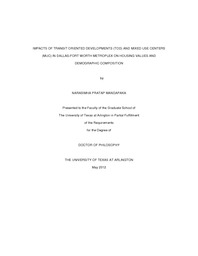
ATTENTION: The works hosted here are being migrated to a new repository that will consolidate resources, improve discoverability, and better show UTA's research impact on the global community. We will update authors as the migration progresses. Please see MavMatrix for more information.
Show simple item record
| dc.contributor.author | Mandapaka, Narasimha Pratap | en_US |
| dc.date.accessioned | 2012-07-25T19:10:00Z | |
| dc.date.available | 2012-07-25T19:10:00Z | |
| dc.date.issued | 2012-07-25 | |
| dc.date.submitted | January 2012 | en_US |
| dc.identifier.other | DISS-11602 | en_US |
| dc.identifier.uri | http://hdl.handle.net/10106/11107 | |
| dc.description.abstract | Suburban sprawl was attributed to be the cause of number of problems such as traffic congestion, depletion of natural resources, and decreasing air quality. Over the past two decades, policy makers and smart growth proponents encouraged Transit-Oriented Developments (TOD) and Mixed Use Centers (MUC) to increase transit ridership and development density; revitalize inner-city neighborhoods; improve environmental quality and livability; and to counteract suburban sprawl and real estate market forces in various communities in the U.S. Though many policy makers, urban planners, environmentalists see significant opportunities in sustainable development, there have been concerns related to affordability of housing combined with transportation, possibly resulting in social inequality in terms of income, race, and ethnicity in sustainable developments in DFW Region. This research study primarily focuses on analyzing the change housing values of MUCs and TODs in the four core counties (Dallas, Tarrant, Collin, and Denton) of the Dallas Fort Worth (DFW) region and its effects on income, race, ethnicity of persons living in housing in MUCs and TODs in the DFW region between 2000 and 2009. The results of the study identified several significant independent or explanatory variables that affect the changes in housing values, median income, and minority percentages in the four-county study area. The groups of variables affecting the above factors include Demographic Variables, Location Variables, Transportation Access Variables, Development Variable, and Housing Supply Variables. These groups include specific variables such as percentage of persons working in professional occupations, distance to parks, number of major employers per square mile, type of development, etc. All these variables were statistically significant in explaining the variation in housing values, changes in income, and changes in minority percentage. Conclusions and policy recommendations were derived from the research study providing a stepping stone for further analysis in this research area. | en_US |
| dc.description.sponsorship | Anjomani, Ardeshir | en_US |
| dc.language.iso | en | en_US |
| dc.publisher | Urban & Public Affairs | en_US |
| dc.title | Impacts Of Transit Oriented Developments (TOD) And Mixed Use Centers (MUC) In Dallas-fort Worth Metroplex On Housing Values And Demographic Composition | en_US |
| dc.type | Ph.D. | en_US |
| dc.contributor.committeeChair | Anjomani, Ardeshir | en_US |
| dc.degree.department | Urban & Public Affairs | en_US |
| dc.degree.discipline | Urban & Public Affairs | en_US |
| dc.degree.grantor | University of Texas at Arlington | en_US |
| dc.degree.level | doctoral | en_US |
| dc.degree.name | Ph.D. | en_US |
Files in this item
- Name:
- Mandapaka_uta_2502D_11602.pdf
- Size:
- 18.62Mb
- Format:
- PDF
This item appears in the following Collection(s)
Show simple item record


